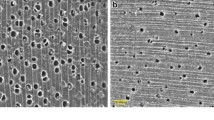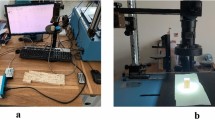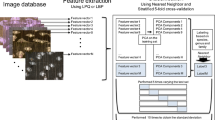Abstract
An automated wood texture recognition system of 48 tropical wood species is presented. For each wood species, 100 macroscopic texture images are captured from different timber logs where 70 images are used for training while 30 images are used for testing. In this work, a fuzzy pre-classifier is used to complement a set of support vector machines (SVM) to manage the large wood database and classify the wood species efficiently. Given a test image, a set of texture pore features is extracted from the image and used as inputs to a fuzzy pre-classifier which assigns it to one of the four broad categories. Then, another set of texture features is extracted from the image and used with the SVM dedicated to the selected category to further classify the test image to a particular wood species. The advantage of dividing the database into four smaller databases is that when a new wood species is added into the system, only the SVM classifier of one of the four databases needs to be retrained instead of those of the entire database. This shortens the training time and emulates the experts’ reasoning when expanding the wood database. The results show that the proposed model is more robust as the size of wood database is increased.











Similar content being viewed by others
References
Baas P, Wheeler E (2000) Dicotyledonous wood anatomy and the APG system of angiosperm classification. Bot J Linn Soc 134:3–17
Bombardier V, Schmitt E (2010) Fuzzy rule classifier: capability for generalization in wood color recognition. Eng Appl Artif Intell 23:978–988
Bremanath R, Nithiya B, Saipriya R (2009) Wood species recognition using GLCM and correlation. In: International conference on advances in recent technology in communication and computing, pp 615–619
Chang CC, Lin CJ (2011) LIBSVM: a library for support vector machines. ACM Trans Intell Syst Technol 2:27
Dawson-Andoh B, Adedipe OE (2012) Rapid spectroscopic separation of three Canadian softwoods. Wood Sci Technol 46:1193–1202
Denzler JK, Weidenhiller A, Golser M (2013) Comparison of different approaches for automatic bark detection on log images. Wood Sci Technol 47:749–761
Fuentealba C, Simon C, Choffel D, Charpentier P, Masson D (2004) Wood products identification by internal characteristics readings. In: Proceedings of the IEEE international conference on industrial technology, vol 2, pp 763–768
Gu IYH, Andersson H, Vicen R (2010) Wood defect classification based on image analysis and support vector machines. Wood Sci Technol 44:693–704
Hermanson JC, Wiedenhoeft AC (2011) A brief review of machine vision in the context of automated wood identification systems. IAWA J 32:233–250
Khairuddin U, Yusof R, Khalid M, Cordova F (2011) Optimized feature selection for improved tropical wood species recognition system. ICIC Express Lett B Appl 2(2):441–446
Khalid M, Eileen LYL, Yusof R, Nadaraj M (2008) Design of an intelligent wood species recognition system. Int J Simul Syst Sci Technol 9(3):9–19
Menon PKB, Sulaiman A, Choon LS (1993) Structure and identification of Malayan woods. Malayan Forests Records No 25, Forest Research Institute Malaysia, Malaysia
Miranda I, Gominho J, Ferreira-Dias S, Pereira H (2014) Pattern recognition as a tool to discriminate softwood and hardwood bark fractions with different particle size. Wood Sci Technol 48:1197–1211
Mokhlis H, Laghari JA, Bakar AHA, Karimi M (2012) A fuzzy based under-frequency load shedding scheme for islanded distribution network connected with DG. Int Rev Electr Eng 7:4992–5000
Molinari F, Gaetano L, Balestra G (2010) Role of fuzzy pre-classifier for high performance LI/MA segmentation in B-mode longitudinal carotid ultrasound images. In: IEEE international conference on engineering in medicine and biology society, pp 4719–4722
Piuri V, Scotti F (2010) Design of an automatic wood types classification system by using fluorescence spectra. IEEE Trans Syst Man Cybern C Appl Rev 40(3):358–366
Qin X, Yang YH (2004) Similarity measure and learning with gray level aura matrices (GLAM) for texture image retrieval. In: Proceedings of the 2004 IEEE computer society conference on computer vision and pattern recognition (CVPR), vol 1, pp 326–333
Qin X, Yang YH (2005) Basic gray level aura matrices: theory and its application to texture synthesis. In: 10th IEEE conference on computer vision, vol 1, pp 128–135
Qin X, Yang YH (2007) Aura 3D textures. IEEE Trans Vis Comput Graph 13(2):379–389
Rojas JAM, Alpuente J, Postigo D, Rojas IM, Vignote S (2011) Wood species identification using stress-wave analysis in the audible range. Appl Acoust 72:934–942
Ruffinatto F, Crivellaro A, Wiedenhoeft AC (2015) Review of macroscopic features for hardwood and soft-wood identification and a proposal for a new character list. IAWA J 36:208–241
Sukanesh R, Harikumar R (2007) A structured soft (max–min) decision trees for patient specific fuzzy classifier in the classification of epilepsy risk levels from EEG signals. In: International conference on computational intelligence and multimedia applications, pp 435–439
Vapnik V, Cortes C (1995) Support vector network. Mach Learn 20:273–297
Wheeler EA (2011) In-sideWood—a web resource for hardwood anatomy. IAWA J 32(2):199–211
Wheeler EA, Baas P, Gasson PE (1989) IAWA list of microscopic features for hardwood identification. IAWA Bull New Ser 10:219–332
Yusof R, Khalid M, Khairuddin ASM (2013) Application of kernel-genetic algorithm as nonlinear feature selection in tropical wood species recognition system. Comput Electron Agric 93:68–77
Acknowledgments
The authors would like to thank Malaysian Ministry of Science, Technology and Innovation (MOSTI), and University of Malaya for funding this research through UMRG Grant (RP023-2012B). The authors would also like to thank Forest Research Institute of Malaysia (FRIM) for providing us with the wood samples.
Author information
Authors and Affiliations
Corresponding author
Rights and permissions
About this article
Cite this article
Ibrahim, I., Khairuddin, A.S.M., Abu Talip, M.S. et al. Tree species recognition system based on macroscopic image analysis. Wood Sci Technol 51, 431–444 (2017). https://doi.org/10.1007/s00226-016-0859-4
Received:
Published:
Issue Date:
DOI: https://doi.org/10.1007/s00226-016-0859-4




